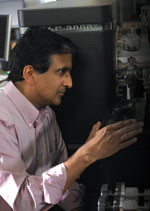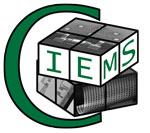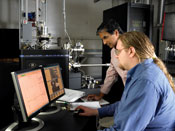 Working with professors from Stanford University, the University of California Berkeley, and the University of Washington, Krishna Rajan is developing a new materials science paradigm to design advanced devices made from nano and microelectromechanical systems (N/MEMS). The project is funded by the Defense Advanced Research Projects Agency (DARPA).
Working with professors from Stanford University, the University of California Berkeley, and the University of Washington, Krishna Rajan is developing a new materials science paradigm to design advanced devices made from nano and microelectromechanical systems (N/MEMS). The project is funded by the Defense Advanced Research Projects Agency (DARPA).
Rajan, professor of materials science and engineering and director of the Institute for Combinatorial Discovery, is a member of the Center on Interfacial Engineering for Microelectromechanical Systems (CIEMS) research group. Located on Stanford’s campus, CIEMS uses a collaborative, interdisciplinary approach to advance the fundamentals of interface and surface-science behavior of N/MEMS to increase the capabilities and performance of these systems.
 N/MEMS are often embedded in technologies such as sensors and actuators. The CIEMS researchers are looking to protect and package these systems as well as the devices within which they have been embedded to withstand a wide range of harsh environments. “To deal with these very complex systems, we use combinatorial methods to make it more efficient to experimentally survey a large number of possibilities,” Rajan said. “This, combined with the mathematical modeling capabilities of informatics, allows us to make novel discoveries.”
N/MEMS are often embedded in technologies such as sensors and actuators. The CIEMS researchers are looking to protect and package these systems as well as the devices within which they have been embedded to withstand a wide range of harsh environments. “To deal with these very complex systems, we use combinatorial methods to make it more efficient to experimentally survey a large number of possibilities,” Rajan said. “This, combined with the mathematical modeling capabilities of informatics, allows us to make novel discoveries.”
During phase I of the CIEMS program, the Iowa State team led by Rajan uncovered new piezoelectric materials for the next generation of high-temperature sensors and actuators. The unique informatics-driven approach that Rajan’s group used to make this finding will be described in an upcoming paper in the prestigious Proceedings of the Royal Society.
CIEMS began phase II of this project after recently receiving a three-year, $15 million award. Phase II of the program will continue the efforts in materials discovery through informatics, but will also take advantage of the unique experimental capability of Iowa State’s atom probe microscope.
“A tom probe tomography is one of the most powerful way to look at materials because it can build a 3D image of billions of atoms based on their chemistry,” Rajan said. “With this kind of information at our disposal, we can do just about anything when it comes to improving and creating new materials, as well as help us understand the fundamental physics and chemistry of interfaces governing N/MEMS behavior.”
tom probe tomography is one of the most powerful way to look at materials because it can build a 3D image of billions of atoms based on their chemistry,” Rajan said. “With this kind of information at our disposal, we can do just about anything when it comes to improving and creating new materials, as well as help us understand the fundamental physics and chemistry of interfaces governing N/MEMS behavior.”
The CIEMS group plans to make significant progress in the next year in creating new devices to meet the needs of the group’s industrial partners, including Boeing, a key partner with Iowa State University and CIEMS.
Another area that excites Rajan is his current efforts to link N/MEMS technology and engineering with the field of medicine and health. One example of a potential application is the ability to use this technology to create devices that can provide healthcare professionals with affordable tools to assist people who may be in a remote environment with limited access to resources such an area devastated by a flood or earthquake.
“That’s the great thing about being part of this group,” Rajan said. “We can apply our unique computational engineering research and atomistic scale imaging capabilities to some very novel ideas. And, with access to the facilities through CIEMS, we can use our results to fabricate new devices and tools that can potentially change the way we solve societal problems.”